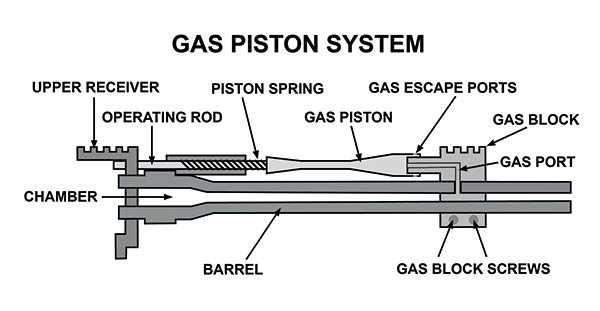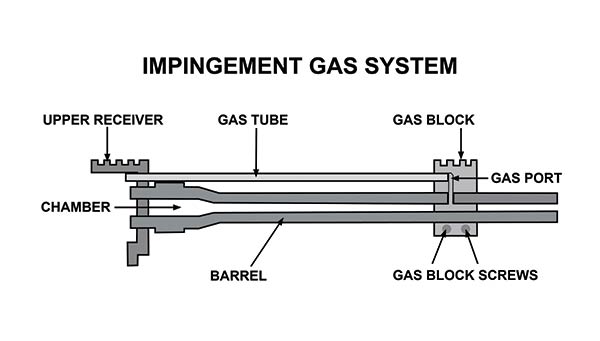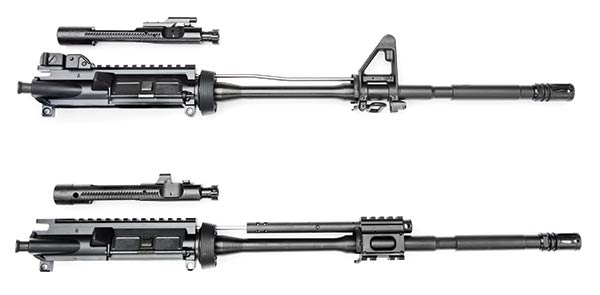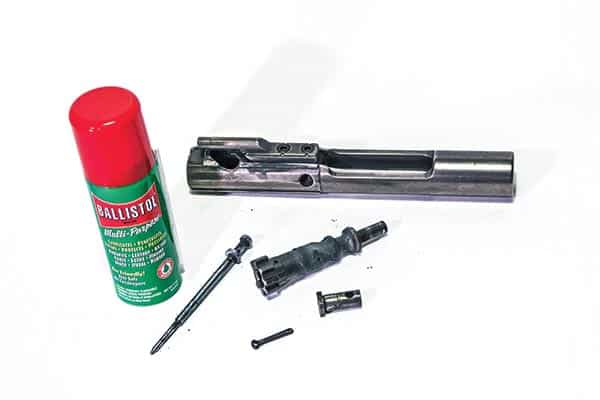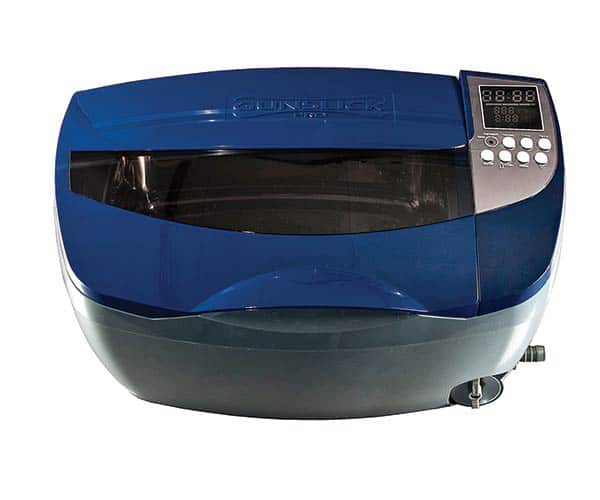5
Gas Vs. Piston
What Difference Does It Make?
The original AR, as designed by Eugene Stoner, functions on the gas-impingement system. With this operating system, as the bullet travels down the barrel, it passes a hole in the top of the barrel and some of the gas pushing the bullet is diverted through this hole. The gas is then directed back through a tube and into the upper receiver where it pushes against the gas key on top of the bolt carrier. This pushes the bolt carrier back and cycles the action.
There are two complaints with this system. The first is that this dispersion of hot gas into the receiver heats up the operating components. During sustained fire this can create a lot of heat, which theoretically causes additional wear. The heat also bakes the carbon residue contained in the gas onto the bolt and bolt carrier, which results in the second complaint, fouling. Some correlate the gas-impingement operating system to a person who poops on the same table they eat off of.
Pooping Where You Eat
Is this pooping where you eat a real problem with the direct-impingement gas system? You can shoot a gas impingement AR enough so that it will become fouled to the point it will not operate reliably. I can’t tell you how much shooting this will require. It depends on the amount of carbon deposits produced by the ammo. It also depends on how hot you get your AR while you’re shooting it.
I have a Smith & Wesson M&P 15 I’ve owned for seven years. I’ve shot it thousands of times. Until a few weeks ago, I’d never, ever cleaned or lubed it. (The only reason I did it then was to test a sonic gun cleaning system.) However, I’ve never fired that carbine enough to get it really hot. Additionally, I’ve taken a variety of carbine training courses where I fired between 500 and 1000 rounds of ammo over several days. Some of those guns got really hot and really dirty. I didn’t clean them either and never had a single functioning issue.
On the other hand, I’ve tested a variety some AR’s using a wide variety of ammo and on occasion I’ve run into functioning problems that were corrected by cleaning after as few as 200 rounds. This might be a good place to add the number one cause of malfunctioning issues with an AR has nothing to do with fouling but is most often caused by faulty magazines.
This might be a good time to interject something else too. Just because an AR is a mechanical device doesn’t mean you need to soak it in lubrication. Indeed, lubrication can make moving parts work together better, but soaking the internals of an AR can cause a problems. If you get excess lubrication in the chamber and bore you can create an over pressure situation that can have disastrous consequences. A little lube goes a long way on an AR if applied correctly.
The gas-piston operating system for an AR has more parts but almost completely eliminates all of the carbon fouling on the bolt and bolt carrier.
The gas-impingement system uses fewer parts and is also less expensive. In the long run it may be easier to maintain and obtain parts for too.
The AK Piston
But back on topic, one of the most reliable battle rifles is the AK 47. Like the AR, the AK runs on gas but instead using direct gas to operate the action, it uses the gas to drive an operating rod. This rod essentially does what the gas in an AR does and pushes the bolt carrier to the rear, cycling the action. The gas is then vented to the outside and never enters the action area of the rifle.
In addition to having a great reputation for reliability, the AK also has a reputation for inaccuracy. In close quarters this is not an issue but if you are trying to hit a man-sized target at 300 or 400 yards, results can be questionable. There are a variety of reasons the AK is not very accurate and one is the piston operating system. But, due to its piston operating system, the AK runs cooler and cleaner than the AR. This led some designers to consider making a piston-driven AR. Some called this an attempt to solve a problem that did not exist while others saw it as the second coming of John Browning.
With a piston-driven AR, when the gas enters the gas block it is used to force a piston or rod back against what’s called the gas key on a gas-impingement AR. On a piston-driven AR this gas key does not have a hole in it. Instead it’s just a solid block for the piston to pound against. All the gas is expunged from the system so the internals of a piston-driven AR stay very clean and cool. On the negative side, the bolt carrier inside an AR, was not designed to be pounded on with a steel rod. Theoretically, this induces undue wear on the operating system.
Also, theoretically, the operating rod makes the rifle less accurate because of its connection to the barrel that can influence torque as the barrel heats and interfere with barrel harmonics as the bullet travels down its length. And finally, the impulse of the piston slapping the bolt carrier changes the way the rifle feels when it recoils. And, though it has nothing to do with the operation of the AR, there’s a down side to the piston driven design; it costs more. Some piston-driven AR’s cost twice as much as gas impingement AR’s. Maybe the real question is, is it worth the money?
Cody Carroll, who now works for Magpul, is intimately familiar with the AR as a battle rifle. Carroll believes the piston system, as used on the HK 416, is superior to the gas-impingement system at the carbine length.
A Soldier’s Opinion
I asked the only super soldier I know his thoughts on the gas impingement/piston question. Cody Carroll works for Magpul in product development and research and has been in the sandbox as a solider and a sniper for the Army and the Marines. He’s pulled a lot of AR triggers when it really mattered. Cody told me, “My thoughts are the gas system works best on mid- and rifle-length guns, but if you want a carbine or PDW, you need a piston. The HK 416 is a tank! I’d trade all of my gas guns for the reliability and life span of the 416.”
The Heckler & Koch HK416 uses the AR-15 platform but was conceived to be an improvement to the Colt M4 carbine. The primary difference is the inclusion of an HK-proprietary short-stroke gas piston system derived from the Heckler & Koch G36. Considering Cody’s background, his opinion is worth listening to.
But his comments also bring up another point. Cody mentioned the mid- and rifle-length gas systems. The gas system for AR’s can vary in length. Usually the length of the barrel dictates this length. There are primarily four different gas system lengths for an AR, pistol, carbine, mid- and rifle-length and they range in length from 4.5″ to 12″ depending on the barrel length of the AR. The general consensus is the longer the gas system (gas tube) the better the gas system will perform.
Oleg Volk Image – On top is the gas-impingement AR operating system and on bottom the gas piston system. Piston-driven AR’s will cost a bit more and will also weigh a few ounces more.
Oleg Volk Image – The bolt assembly on top is for a gas-impingement AR, the one on the bottom is for a gas piston AR. Notice the difference in the gas key on top of the bolt carrier.
Experience Has Shown
Ultimately, it’s a call only you can make. As someone who tests and reviews guns for a variety of firearms periodicals I’ve had the opportunity to test versions of both the gas impingement and piston-driven AR’s. Based on those tests here are the facts as I see them:
Piston-driven guns run much cleaner. You can fire as few as a magazine and see the difference.
Piston-driven guns also run much cooler. You’ll have to shoot several magazines in a hurry to notice the difference.
On average, piston-driven guns are less accurate. This does not mean piston-driven AR’s are not accurate, but looking over my test records, the most accurate AR’s I’ve tested have been those, which work with the gas-impingement system.
Cost-wise, piston-driven guns tend to be more expensive. This observation must be qualified with it depends. There are some very expensive gas impingement AR’s and some piston-driven AR’s that are not all that expensive.
Both piston-driven and gas-impingement guns are very reliable. But, parts for gas-impingement guns are easier to find, cost less and in many cases are interchangeable between manufacturers.
Now, here is the good news. The unmatched modularity of the AR allows you to, in a way, have your cake and eat it too. If you own a gas-impingement AR and want to try a piston-driven AR, just purchase a piston-driven upper receiver. Since the gas-impingement and piston systems work independently of the lower receiver, you can alternate between them on the same lower receiver.
The AR is the most adaptable and versatile rifle in existence. No other weapon platform offers you as many options or will allow you to go between different operating systems with as much ease as the AR. So, if you can’t decide between a gas-impingement and a piston AR, get both, shoot them both and find out for yourself if the piston is an answer to a problem that never existed.
NOTE: This article is a condensed version of a chapter in Richard Mann’s new book, The Gun Digest Shooter’s Guide to the AR, which should be on shelves by summer 2014. Contact Gun Digest, ww.gundigest.com to order your copy.
This bolt group is from a gas impingement driven AR that just digested 200 rounds. Notice the carbon fouling on the carrier and the bolt. Ballistol will kick the carbon right off these parts
If you are looking for an easy way to clean carbon fouling from your AR’s bolt and bolt carrier, consider the sonic cleaner from Gunslick.
Cleaning An AR
If you are a gas impingement kind of guy then you already know how dirty the bolt and bolt carrier of an AR can get. You probably already have a routine established for removing all the carbon fouling but here are two options you may not have considered. One you can use on the range or anywhere for that matter. The other is a—back at the house—cleaning option but it requires very little effort on your part.
Ballistol has been around since before WW II when German soldiers used it to maintain the metal and wood parts of their weapons and to treat minor wounds, scratches and sores. It is a biodegradable solution that removes carbon fouling like nobody’s business. Just spray it on and wipe the carbon away. You can even mix this stuff with water to wash your truck!
Gunslick’s Sonic Cleaner uses the high frequency pressure or sound, created by the device, to agitate a water based cleaning solution. This causes contaminates and carbon-fouling adhering to gun parts to release. You drop the bolt and bolt carrier in the unit and walk away. By the time you get the bore and the rest of the AR clean, the sonic cleaner will have done its stuff.


